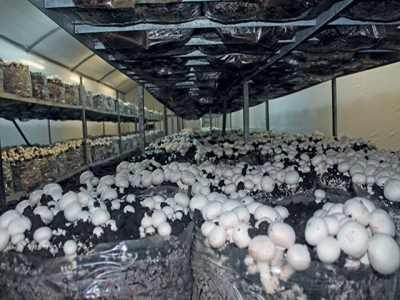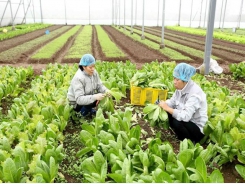Mushroom production tips from a Boland farmer

For small-scale mushroom farmers in South Africa, production can be a challenge. But Wilmaré Lotz of Boland Mushrooms succeeded in doubling production in her first year as manager. Specialising in button mushrooms, the business employs 36 members of the local community and produces approximately 6,5t of mushrooms a week.
Since Boland Mushrooms doubled its production six years ago, it produces about 6,5t of mushrooms per week. Photo: Jeandré du Preez
Wilmaré Lotz grew up helping her father on his mushroom farm near Rawsonville at weekends and in school holidays. Yet despite this exposure, she was never particularly interested in mushroom farming as a youngster.
All this changed, however, while she was working on her master’s dissertatio n on anaerobic composting. This was slightly ironic, she says, as anaerobic composting is in fact the exact opposite of the composting used in mushroom farming!
After completing her studies, Wilmaré worked on mushroom farms locally and abroad to gain experience.
Learning by trial and error
Then, as now, there were few courses available on mushroom growing in South Africa and this made it challenging for an aspiring mushroom farmer. It was also a ‘closed’ industry: producers were not that keen to share their knowledge with potential competitors.
Therefore, when Wilmaré started working for the family business, Boland Mushrooms, in 2002, she had to learn everything by trial and error.
At that stage, 3t of mushrooms – kept in eight growing rooms – were harvested per week.
In 2009, after the death of her father, Theo Griessel, Wilmaré faced a difficult decision: should she try to continue in the business on her own? Her doubts were soon dispelled by her success: after just a year at the helm of the business, she managed to double the farm’s production.
The heart of the business
The growing cycle of mushrooms starts with compost, and it is therefore important to ensure that this has the right ingredients and is treated optimally from the beginning.
“Compost is the heart of your business. If the composition isn’t correct, it can affect your crop and your yield,” she stresses.
Boland Mushrooms’ main production line, button mushrooms (Agaricus bisporus), require highly specialised compost. Wilmaré produces her own compost, which involves mixing wheat straw, chicken manure, gypsum and water, on site. It takes three weeks for these raw materials to ferment, and the compost is aired daily to prevent unpleasant odours developing.
“If there’s a bad smell in the air, there’s something wrong with your compost,” she says.
After three weeks, the fermented compost is moved from the yard to a closed room – the pasteurisation room – where it undergoes three developmental phases. The first consists of steadying the temperature of the compost. The second comprises raising its temperature to 58°C for eight hours, thereby getting rid of weeds and insects.
In the third phase, the ammonia and nitrogen content is converted to protein to act as a growth medium for the mushrooms.
According to Wilmaré, mushroom farming in South Africa is different to that in other countries.
“All mushroom farms in South Africa have their own compost yards and growing facilities. Overseas, compost is produced by specialised companies, making it very easy to grow mushrooms.”
Putting down roots
Once the compost is ready, recyclable mushroom cultivation bags are filled with compost and incubated with mushroom spawn. Wilmaré uses sterile grains inoculated with mushroom spores. The bags are placed in growing rooms in which the compost temperature is maintained between 25°C and 27°C.
The oxygen level in the rooms is also kept low so that the spawn can grow, producing a thread-like network of mycelium throughout the compost. All heating and temperature regulation at Boland Mushrooms is done manually.
When a bag of compost is fully colonised with mycelium, a casing layer is added.
“This is very important, as it provides moisture for the mushrooms,” explains Wilmaré.
Most mushroom growers use peat moss, but since last year she has used a sugar cane pith product called Mabu. Pith is a by-product of the process of manufacturing paper from sugar cane bagasse.
“Peat moss is very expensive because we have to import it. Using locally produced pith is substantially cheaper and also reduces our carbon footprint significantly,” she explains.
Optimal thickness for the casing layer is 5cm. This allows for a sufficient moisture content, which creates a favourable microclimate for mushroom growth.
Once the mycelium has grown to its full extent in the casing phase, the temperature in the compost is lowered to 21°C and fresh air is introduced to the room. This temperature shock and gaseous exchange is a sign for the mycelium to start sprouting mushroom initials (pins).
Harvesting
A mushroom doubles in size every 24 hours, so it is imperative that the mushrooms be checked daily. Harvesting, which is done by hand, is highly labour- intensive and involves twisting the mushrooms off at the base.
“This guarantees that they will be removed from the beds undamaged. We want to leave the casing soil in the bag intact as it’s needed for the subsequent flushes of mushrooms,” she explains.
Picking fresh mushrooms cannot be delayed. “You can’t leave a mushroom till the next day. They’ll start to cup or open fully. This makes them B-grade mushrooms, which means less profit,” says Wilmaré.
Training is key
Training is taken seriously at Boland Mushrooms.
“We do in-house training on mushroom picking, which improves our employees’ productivity and efficiency. We developed course material for the training that specifically applies to Boland Mushrooms’ operation,” says Wilmaré.
Despite doubling production, the number of employees has remained more or less the same due to improved productivity.
Bulk market
Boland Mushrooms sells mainly fresh mushrooms in bulk (5kg boxes) to restaurants in the greater Cape Town area, and delivers a small quantity to the Breede River Valley and faraway Upington. Some punnets are also sold off the farm. Deliveries are done daily with three vans.
“We are dedicated to delivering the freshest, highest-quality mushrooms and providing good customer service to our clients,” Wilmaré says.
Related news
Tools

Phối trộn thức ăn chăn nuôi

Pha dung dịch thủy canh

Định mức cho tôm ăn

Phối trộn phân bón NPK

Xác định tỷ lệ tôm sống

Chuyển đổi đơn vị phân bón

Xác định công suất sục khí

Chuyển đổi đơn vị tôm

Tính diện tích nhà kính

Tính thể tích ao



 Vietnam exporters hope for good sales in US…
Vietnam exporters hope for good sales in US…  1-2 years more for pepper export to grow
1-2 years more for pepper export to grow